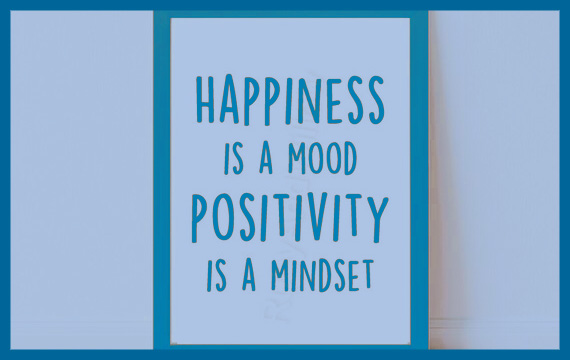Happiness is a Mood, Positivity is a Mindset
Satisfaction and inspiration, frequently utilized reciprocally, are particular parts of our profound and mental prosperity. Positive thinking, on the other hand, is a more in-depth mindset that can be developed and maintained over time. While happiness is frequently regarded as a fleeting mood influenced by external factors,
Introduction
Definition of Happiness
Happiness is an intricate inclination portrayed by sensations of happiness, satisfaction, and fulfillment. It is an emotional encounter impacted by different outer and inner elements.
Distinction between Mood and Mindset
Understanding the difference between mood and mindset is crucial. Moods are transient and can be influenced by external events, whereas mindset reflects a more enduring outlook shaped by internal beliefs and thought patterns.
Importance of Positivity
Positivity goes beyond momentary happiness. It involves cultivating a mindset that embraces optimism, resilience, and a proactive approach to life’s challenges.
Understanding Happiness as a Mood
Temporary Nature
Moods, by their nature, are temporary. They can be influenced by external events such as achievements, relationships, or environmental factors.
External Factors
External factors like weather, social interactions, or even daily stressors can significantly impact one’s mood, leading to fluctuations in happiness levels.
Impact on Well-being
Understanding happiness as a mood highlights the importance of enjoying positive moments while recognizing their impermanence. It emphasizes the need for resilience during challenging times.

Positivity as a Mindset
Sustainable State
Energy, then again, is a mentality that can be supported independent of outer conditions. It includes taking on an inspirational perspective on life and zeroing in on arrangements as opposed to issues.
Internal Factors
A positive mindset is cultivated through internal factors such as self-talk, belief systems, and the ability to reframe challenges as opportunities for growth.
Effects Over Time
Positive thinking has a lasting impact on one’s mental and emotional health, which in turn contributes to a sense of fulfillment and overall contentment in one’s life.
The Science Behind Happiness and Positivity
Neurological Aspects
Research recommends that happiness and inspiration have neurological relations, with the arrival of synapses, for example, dopamine and serotonin assuming a significant part.
Hormonal Influences
Hormones like oxytocin, often referred to as the “love hormone,” are associated with positive emotions and social bonding, highlighting the physiological basis of happiness.
Psychological Perspective
Psychologically, cultivating a positive mindset involves practices such as cognitive reframing, gratitude, and mindfulness, influencing one’s overall perception of life.
Cultivating a Positive Mindset
Gratitude Practices
Incorporating gratitude into daily life is a powerful way to shift focus from what is lacking to what is present, fostering a positive mindset.
Mindfulness Techniques
Mindfulness involves being fully present in the moment, reducing stress, and promoting a positive outlook. Practices like meditation contribute to developing mindfulness.
Positive Affirmations
Affirming positive beliefs about oneself and the future can reshape thought patterns, reinforcing a constructive mindset.
Nurturing Happiness in Daily Life
Healthy Lifestyle Choices
Actual prosperity and emotional well-being are interconnected. A healthy diet, regular exercise, and enough sleep all contribute to happiness and positivity.
Building Meaningful Connections
Positive relationships play a pivotal role in sustaining happiness. Cultivating meaningful connections fosters a sense of belonging and support.
Pursuing Passion and Purpose
Engaging in activities that align with one’s passions and values adds a sense of purpose to life, contributing to long-term happiness.

Overcoming Challenges to Positivity
Dealing with Negativity Bias
The human brain tends to focus on negative events. Overcoming negativity bias involves consciously directing attention towards positive aspects.
Coping with Adversity
Developing resilience is key to maintaining positivity during challenging times. Viewing setbacks as opportunities for growth contributes to a positive mindset.
Learning from Setbacks
Positivity involves learning from failures and setbacks rather than viewing them as insurmountable obstacles. Each challenge becomes a stepping stone toward personal development.
Happiness and Positivity in Professional Life
Impact on Work Performance
A positive mindset enhances productivity and creativity in the workplace. It fosters a collaborative environment and contributes to professional success.
Fostering a Positive Workplace Culture
Organizations benefit from cultivating a positive workplace culture, where employees feel valued and supported in their personal and professional growth.
Balancing Ambition and Contentment
Striking a balance between ambition and contentment is essential. While setting goals is important, appreciating current achievements contributes to sustained happiness.
The Role of Mindfulness in Sustaining Positivity
Mindful Living Practices
Incorporating mindfulness into daily life involves being fully present, reducing stress, and enhancing overall well-being.
Mindful Decision-Making
A positive mindset influences decision-making. Mindful choices align with one’s values and long-term goals, contributing to sustained positivity.
Mindfulness in Relationships
Applying mindfulness to relationships involves active listening, empathy, and understanding, fostering positive connections.
Achieving a Balance: Embracing Both Mood and Mindset
Recognizing the Interconnectedness
Acknowledging the interplay between happiness as a mood and positivity as a mindset is essential for a holistic approach to well-being.
Blending Happiness as a Mood and Positivity as a Mindset
Achieving a balance involves enjoying the fleeting moments of happiness while nurturing a positive mindset that endures through life’s ups and downs.
Impact on Mental Health
Mental Health Benefits of Happiness
Positive emotions contribute to mental well-being, reducing the risk of mental health disorders and enhancing overall resilience.
Positivity as a Protective Factor
A positive mindset acts as a protective factor, buffering against stress and contributing to mental resilience during challenging times.
Common Misconceptions About Happiness and Positivity
External Validation
Relying on external factors for happiness is a common misconception. True positivity comes from within, independent of external validation.
One-Size-Fits-All Approach
There is no universal formula for happiness and positivity. Individuals must discover what practices and mindsets work best for them.
The Pursuit of Perfection
Chasing perfection often leads to dissatisfaction. Embracing imperfections and learning from mistakes contribute to a positive mindset.
Case Studies: Real-Life Examples
Personal Transformation Stories
Real-life examples demonstrate the transformative power of cultivating positivity, showcasing individuals who have overcome challenges through a positive mindset.
Success in Cultivating Positivity
Highlighting success stories emphasizes that sustained positivity is achievable through consistent effort and a commitment to personal growth.
Lessons Learned
Extracting valuable lessons from real-life examples provides insights into the practical application of positivity in diverse situations.

Practical Tips for Daily Positivity
Morning Routines
Incorporating positive habits into morning routines sets a positive tone for the day, influencing overall mood and mindset.
Evening Reflections
Reflecting on positive moments before bedtime reinforces a gratitude mindset, contributing to a more positive outlook on life.
Consistency and Patience
Developing a positive mindset is a gradual process. Consistency in practicing positive habits and patience are key to long-term success.
Conclusion
Recap of Key Points
Understanding the distinction between happiness as a mood and positivity as a mindset is crucial for holistic well-being.
Encouragement for Readers
Encouraging readers to embrace both moments of happiness and the cultivation of a positive mindset for sustained well-being.
FAQs
Can positivity be cultivated even in challenging circumstances?
Absolutely. Cultivating a positive mindset involves adapting and finding growth opportunities even in difficult situations.
How does mindfulness contribute to happiness?
Mindfulness helps individuals focus on the present moment, reducing stress and fostering a positive outlook on life.
Is happiness purely dependent on external factors?
While external factors can influence mood, true happiness comes from cultivating an internal positive mindset.
Can a positive mindset impact physical health?
Yes, research suggests that a positive mindset can have positive effects on physical health, including a strengthened immune system.
What role does gratitude play in sustaining happiness?
Practicing gratitude enhances one’s appreciation for the positive aspects of life, contributing to a sustained sense of happiness.
Suggested Posts:
How to Change from a Negative to a Positive Mindset

